Long tails are sometimes seen on several species of butterflies and moths. They make some species look completely different.
The exact purpose of these tails remains unknown. Only a handful of studies have been published on the role of these tails.
Most researchers agree these tails have a purely-defensive role. Butterflies and moths rely on these tails to keep predators further away from the wings or the body in case of an attack.
Some speculations exist since there’s not a lot of information on the tails of butterflies and moths. In many species, a difference in body structure is tied to mating, but this is not the case with butterflies and moths.
These species rely on long tails for different reasons, mainly to defend themselves given their delicate nature.
Bats are some of the most common types of butterfly and moth predators. Long tails prove efficient against bats.
Long tails on butterflies can also help distinguish thousands of species between them.
Table of Contents
Why do Some Butterflies and Moths Have Long Tails?
Butterflies and moths are among the most exposed insects. They can’t fly fast or high in many cases which exposes them to a range of predators such as bats and birds.
Long tails in moths and butterflies are believed to be a manifestation of a defensive tactic.
Butterflies and moths use long tails to divert a predator in different ways.
To keep bats away
Bats are among the most common butterfly and moth predators. A typical bat can attack multiple butterflies quickly as it can fly faster.
Bats can also wrap their wings and legs around moths and butterflies which makes it much more difficult for the prey to escape.
As a result, some moths and butterflies have evolved to divert the attacks of bats.
To deflect echoes
Bats move and hunt based on high-pitched squeaks. These create an echo or what is known as a rebounding echo.
How these high-pitched squeaks rebound off walls, caves, rocks, trees, bugs, and insects is what dictates the reaction of bats.
Tails in moths and butterflies deflect these high-pitched squeaks to their advantage.
Even if a bat would find their location, it would still be slightly off a full attack as it would be the tail that the echoes pick up first.
To deflect an attack toward the tail
Ultimately, moths and butterflies have tails to lure predators to a less important area of the wings. A full-scale attack on their body or central sections of their wings would be fatal.
Butterflies can survive superficial tail attacks. They cannot survive full-on attacks and even minor injuries to the body.
Other types of predators might also consider moths and butterflies. Small birds such as robins are among the species that also go for butterflies.
Higher survival chances are characteristic of butterflies and moths regardless of the predator whenever the predator goes for the tail first.
To make up for a slow flying speed
Many butterflies and moths are slow fliers. They only cover short distances since they can fly in zig-zag patterns or an up-and-down pattern.
This means their long tails don’t leave them as exposed when chased by a faster predator.
Butterflies and Moths With Long Tails
The following species of moths and butterflies are particularly known for their long tails. These are species with a common presence in North America, Central America, South America, Asia, and Europe.
1. Long-tailed Skipper
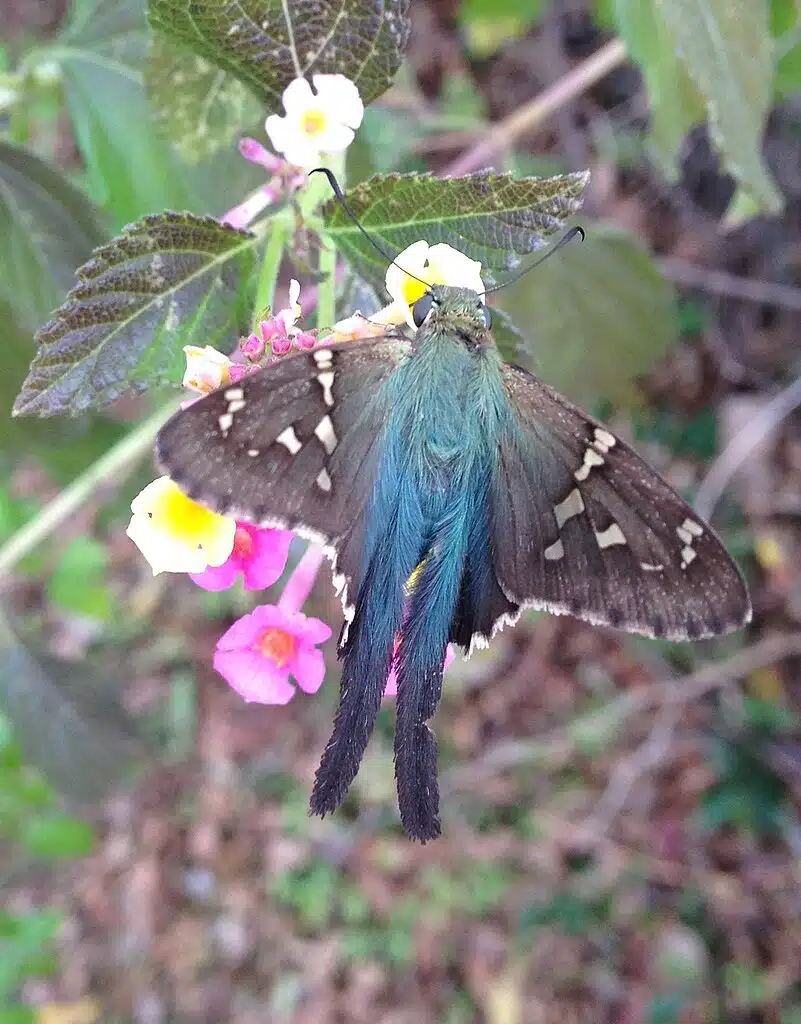
Long-tailed Skippers (Urbanus proteus) are some of the most common butterflies in Eastern and Southeastern parts of the United States.
These butterflies have a blue-green body and brown wings. 2 long brown tails are further seen on the lower part of the wings.
These tails always have a dark color. They can be either dark brown, dark gray, or black. The body of the species can also slightly vary in coloring.
Most Long-tailed Skippers have colorful bodies with a green hue on the head and a blue tint on the lower body. Some can be closer to green while others closer to blue in coloring.
Butterflies of this genus also have off-white spots across the wings. Bright spots or margins aren’t specific to their long tails.
2. Dorantes Longtail
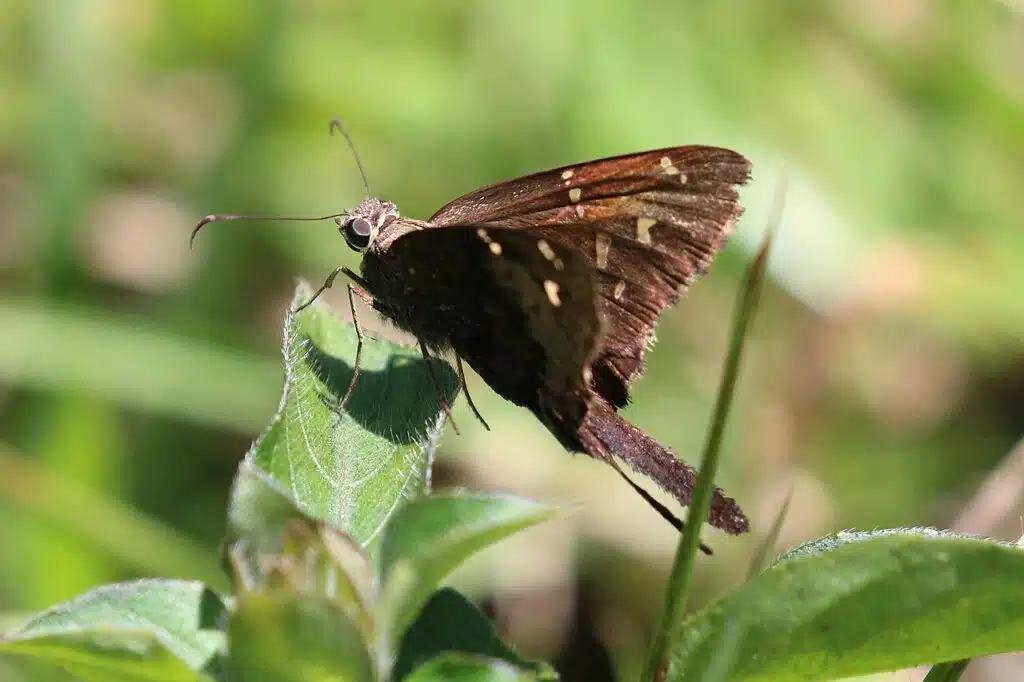
This species (Thorybes dorantes) is native to Florida and Southern Texas. Dorantes Longtails are among the species that have a wingspan of up to 51mm.
The brown color is specific to the species.
Yellow and black marks are specific to the dorsal and ventral sides of its wings. Its long tails have no bright spots or patterns.
Brown wings with dark brown to black tails on the lower hindwings are specific to the species.
You can find Doranted Longatils feeding on shepherd’s needle and similarly nectar-rich plants.
However, this species is seen as a major pest on bean crops. The larvae of the species rely on beans and other legumes for food.
3. Brown Longtail
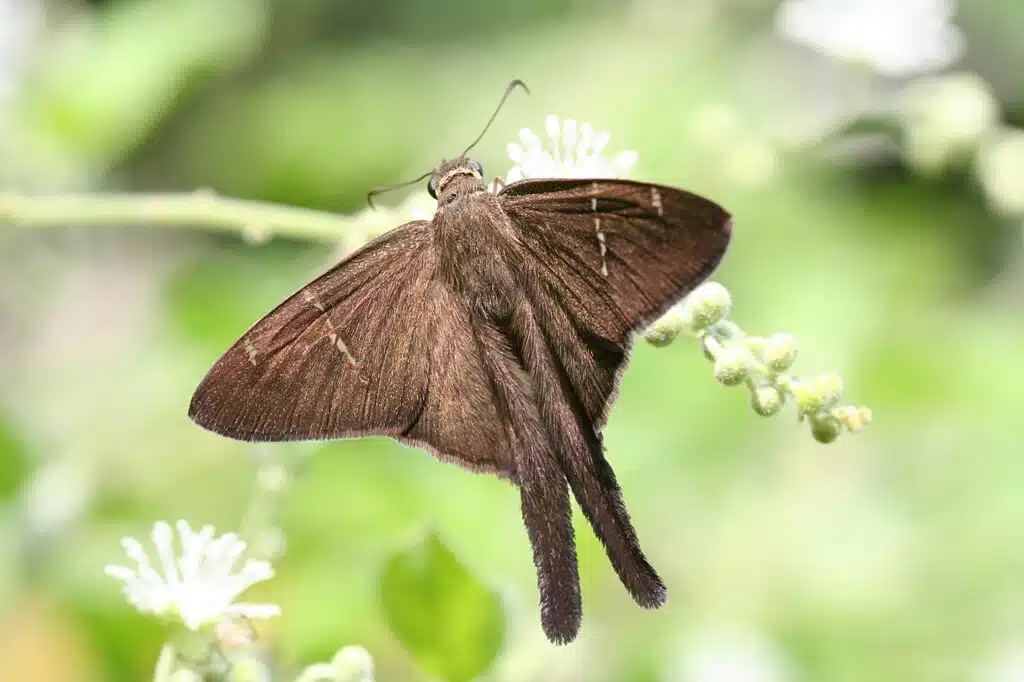
Brown Longtails (Spicauda procne) are native to North America.
They represent a species with a medium to large size as they have a wingspan of up to 48mm.
This species has a base dark brown color. It features black sections such as black veins and black margins.
Its tails are mostly dark brown exhibiting wide black margins.
The species has a hairy body and hairy wings. Long brown hairs are further seen on its 2 tails.
Brown Longtail butterflies are only found in Southern Texas in the US. They mostly live in Central America.
Butterflies of this family may rarely end up in California on the warmest summers.
They aren’t a good sign in the garden or on lawns.
Brown Longtail butterflies feed on various types of grass.
4. Zilpa Longtail
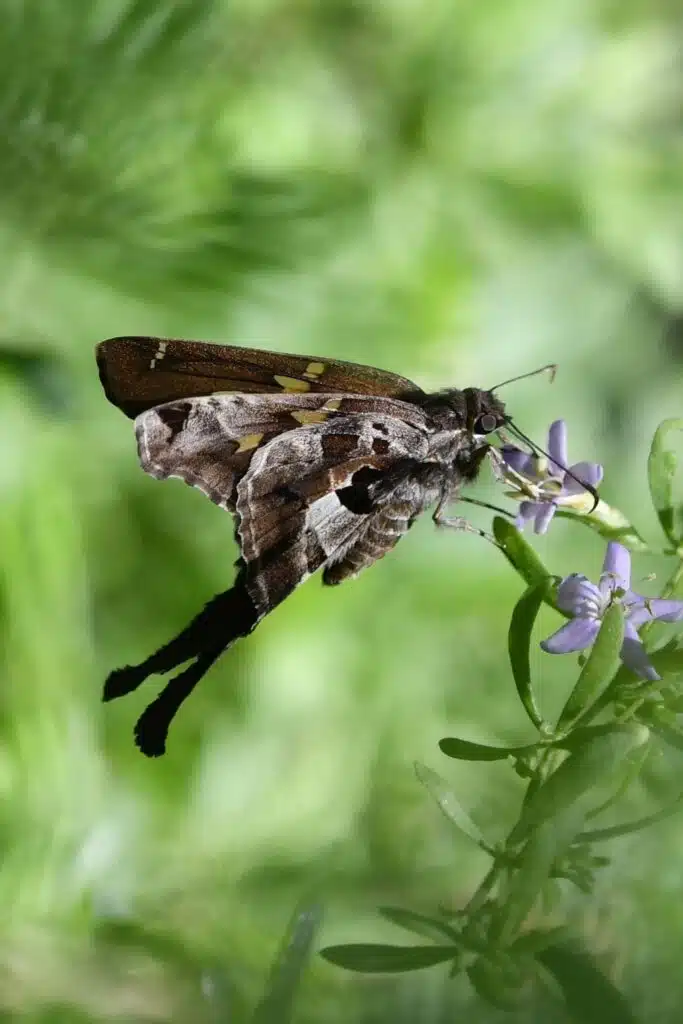
Zilpa Longtails (Chioides zilpa) are seen in tropical climates. The species is also native to the extreme Southern territories of the US in Texas, New Mexico, and Arizona.
You can identify the species by its brown coloring and long tails or projections from the lower hindwings.
Yellow or white spots decorate the dorsal and ventral side of its wings but these spots aren’t seen on its dark tails.
Feeding on flower nectar, Zilpa Longtails have a small size. Their wingspan measures anywhere between 1 and 2 inches while their tails can measure up to 1.5 inches.
Zilpa Longtails are seen in the spring and the fall in the US.
They only have a continuous year-round presence in Central America.
5. White-striped Longtail
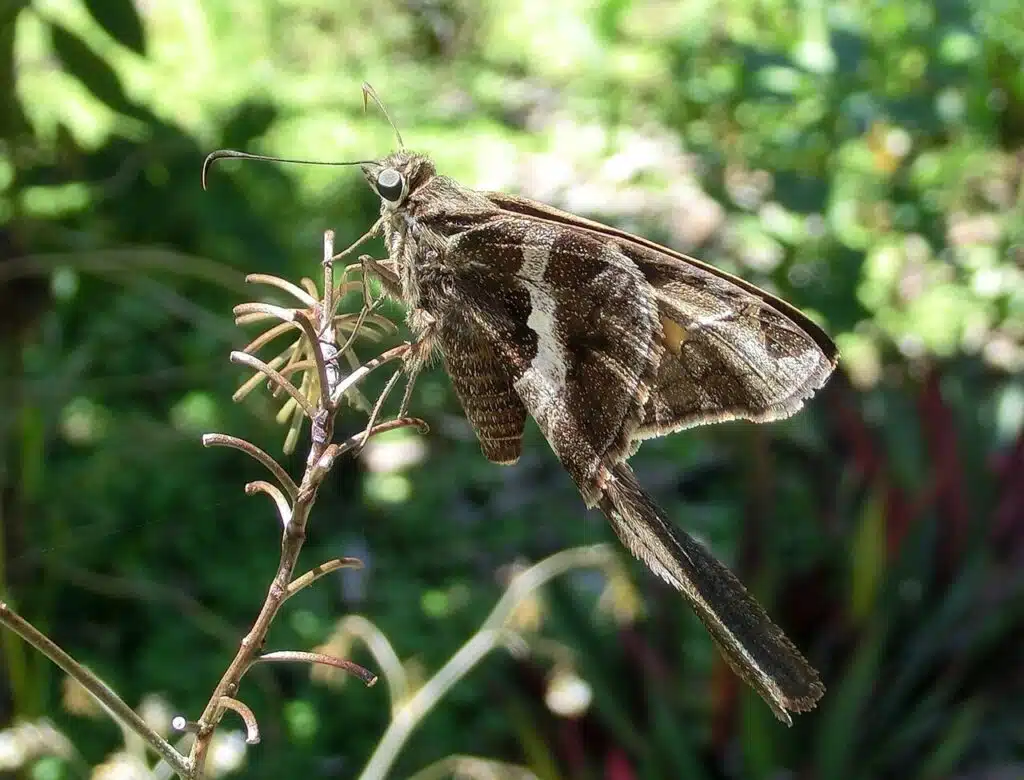
White-striped Longtails (Chioides albofasciatus) get their name from their wide white band across the wings.
The species has dark brown and black-dominant coloring.
With a wingspan of just over 2 inches, these are some of the Longtails with the longest tails in the US.
Flower nectar is the only food source White-striped Longtails consider.
As a result, you can see the species around pea family plants on crops or in the garden as larvae and on Shepherd’s needle as adults.
White-striped Longtails have a different flight season in the US. Southern Texas is the only place where the species flies throughout the year.
6. Blurry-striped Longtail
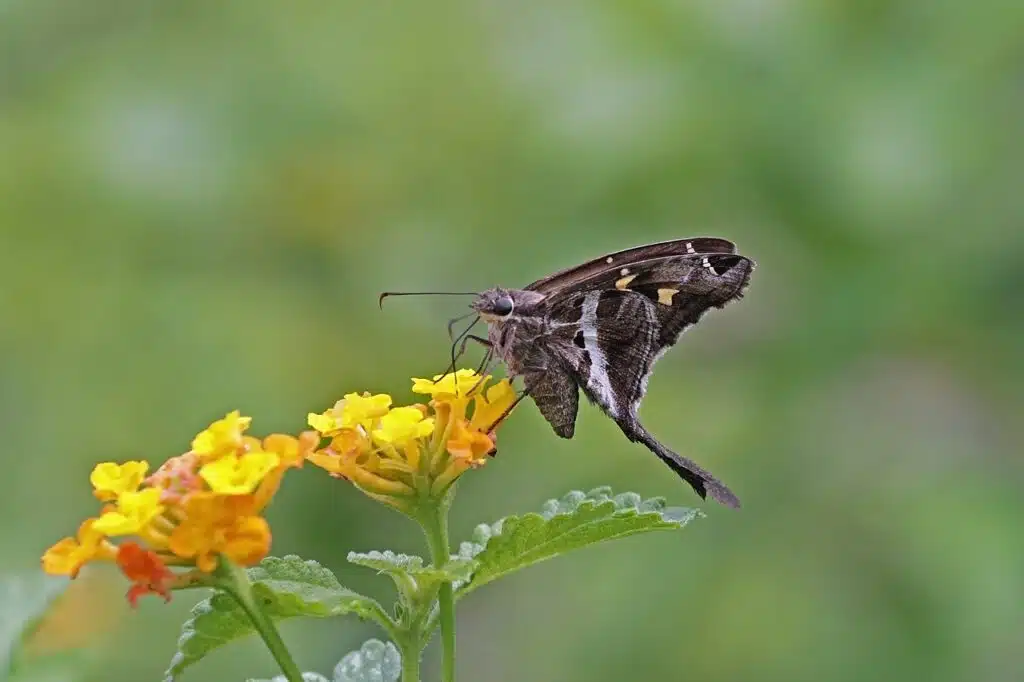
Blurry-striped Longtails (Chioides catillus) are among the most commonly dark brown species with tails.
There are 2 long tails at the base of the hindwings. These are dark brown to black with tiny brown hairs across.
Light brown coloring is specific to the inner parts of the wings while the outer parts have black colors.
Tan spots are seen on the outer side of the forewings.
The body of the species has a light brown to gray color.
The ventral coloring of the wings is lighter but the ventral tails are also black and dark brown.
Light brown colors dominate the ventral wings with black and white spots decorating the inner parts of the wings.
7. Plain Longtail
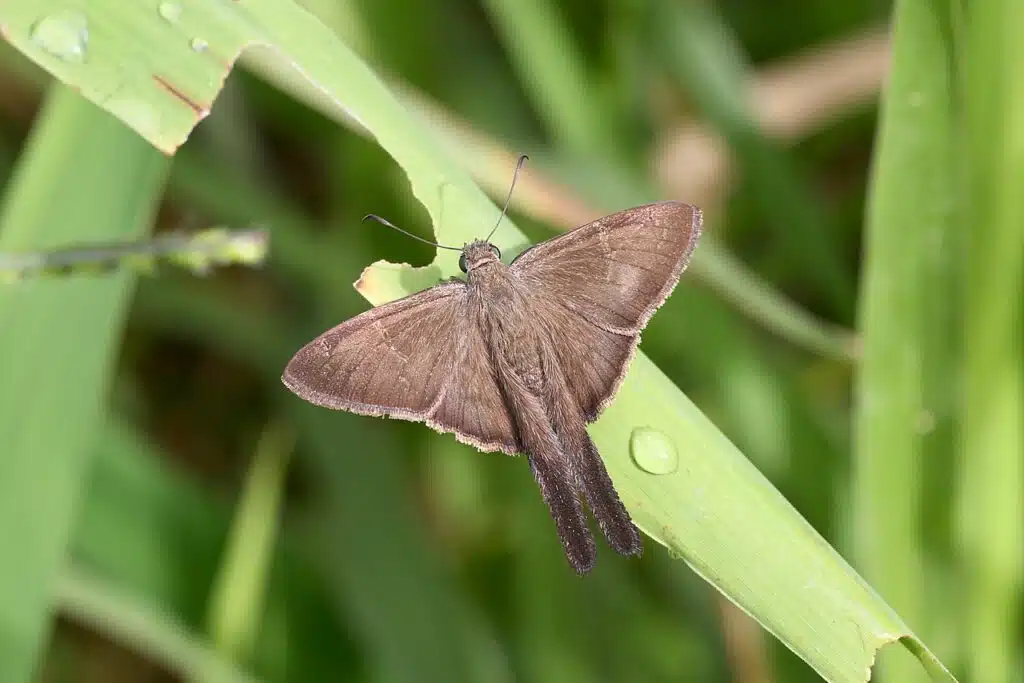
Plain Longtails (Spicauda simplicius) get their name from their plain brown color. This is a species that has a dark brown color across the wings and the body.
Long brown hairs cover almost the entire dorsal surface of the Plain Longtail.
1 long white stripe and 1 short white stripe are seen across the outer edges of the forewings.
This species has 2 long tails which are completely black.
Plain Longtails also have long black antennae with brown tips.
Its tails don’t resemble the rest of the body. They aren’t meant to visually attract predators towards the lower hindwings.
They are meant to distract bats with their ultrasounds which might not be able to exactly pinpoint their location.
8. Teleus Longtail
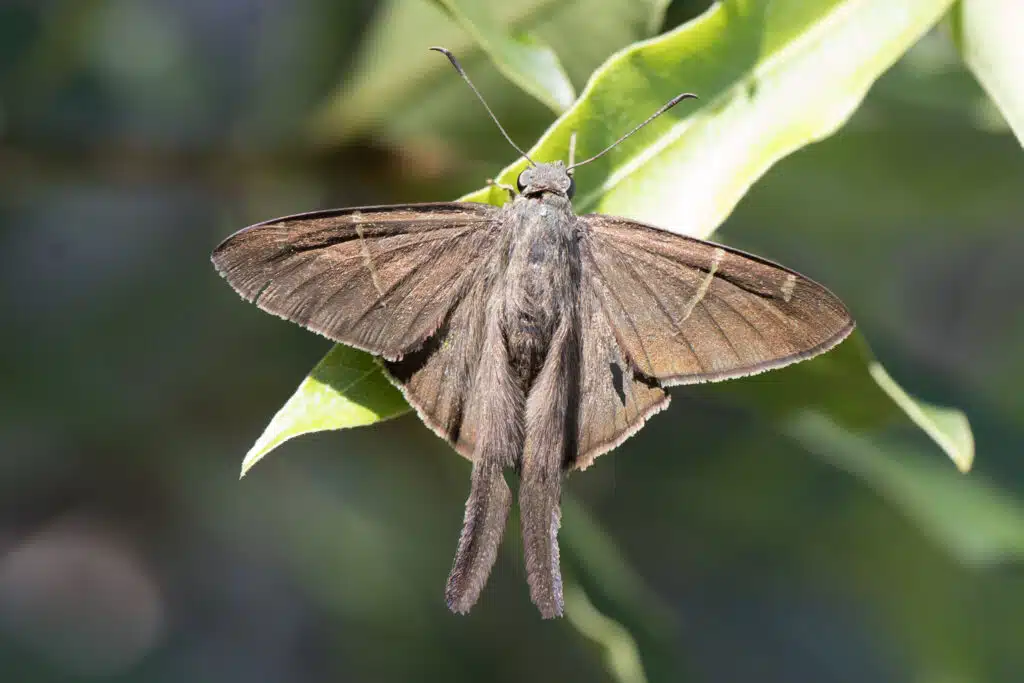
2 long tails (Spicauda teleus) are seen on this species. Found in Southern US, this species has a brown base color.
Its forewings are brown with yellow stripes. Each forewing has 1 long and 1 short yellow stripe.
Its hindwings are all-brown with yellow margins.
The body of the species is gray to dark brown. Its tails are either dark brown or black.
This species is among the few that has highly similar dorsal and ventral colors. This is why it looks
almost the same from all angles.
You might see the species in south Texas as well as in other regions across Central America such as Mexico and Guatemala.
9. Tanna Longtail
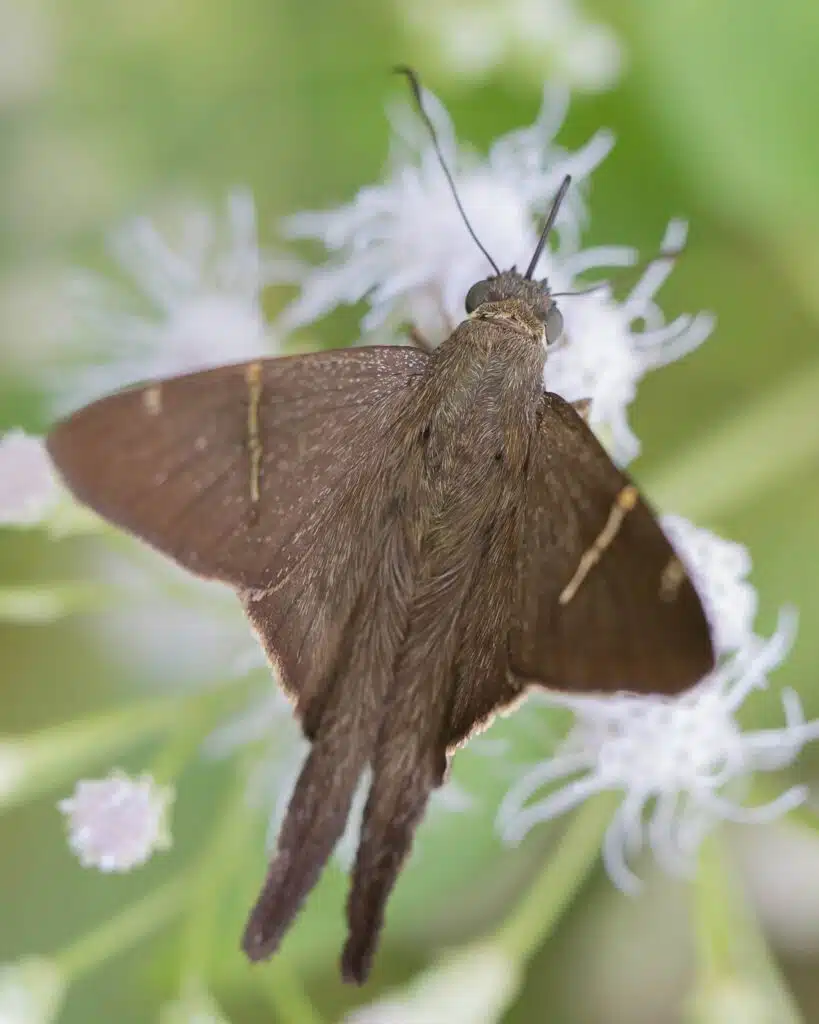
Tanna Longtails (Spicauda tanna) resemble other Spicaudas in size and coloring.
This species has a dark brown color that dominates the forewings and the hindwings. Light brown colors are seen in the form of stripes across its forewings.
Black margins decorate these light brown stripes.
Its hindwings are brown with barely visible black veins.
The tails of the species are black and connected to the black margins of its hindwings.
Tanna Longtails have a dark brown body with black bands across.
Long thread-like black antennae also characterize Tanna Longtails.
The ventral color of the wings is somewhat similar to the dorsal color, but with extra black bands. A dark brown color is specific to its ventral wings.
Black and light brown brands decorate the underside of the wings.
10. Asine Longtail
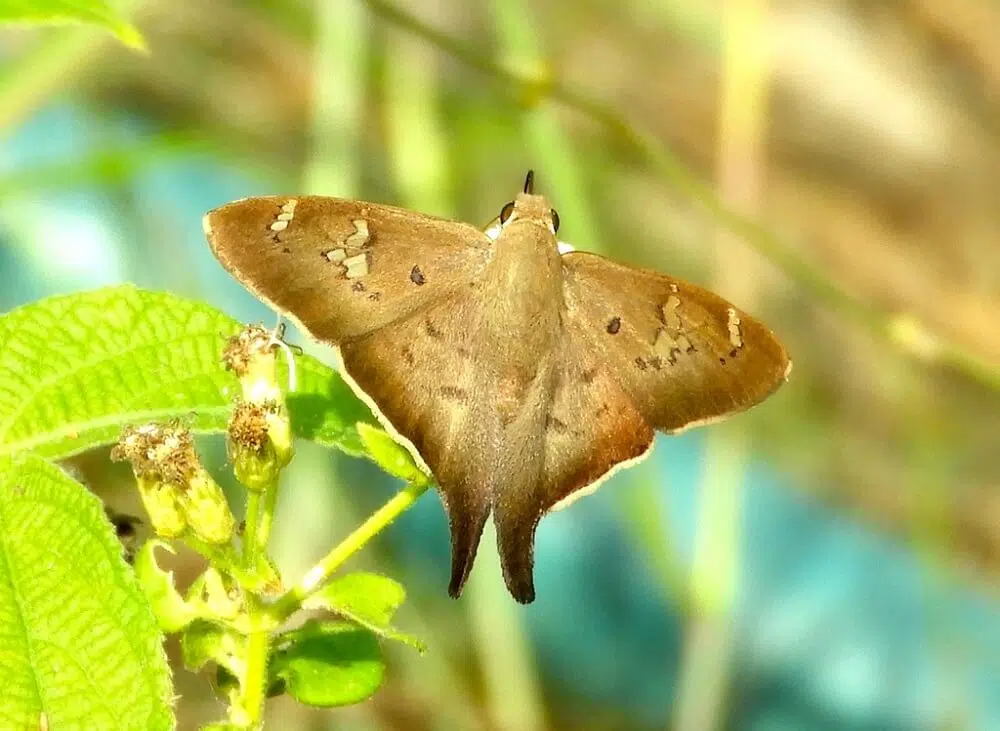
This species (Ectomis asine) of Ectomis is highly similar to most other species of brown Ecotmis.
Subtle differences are only seen in the number and positioning of the white spots on to forewings.
This species has 4 white spots on each upper side of its forewings while the rest of its wings are brown.
Other Ectomises have multiple other spots on their brown wings.
2 long black tails are seen on Asine Longtails.
As with other species of butterflies and moths, the tails are darker than the base color of its wings.
The body of the species has a dark brown color with black spots on the upper side.
This species is a distant yet common relative of other skippers.
11. Esmeralda Longtail
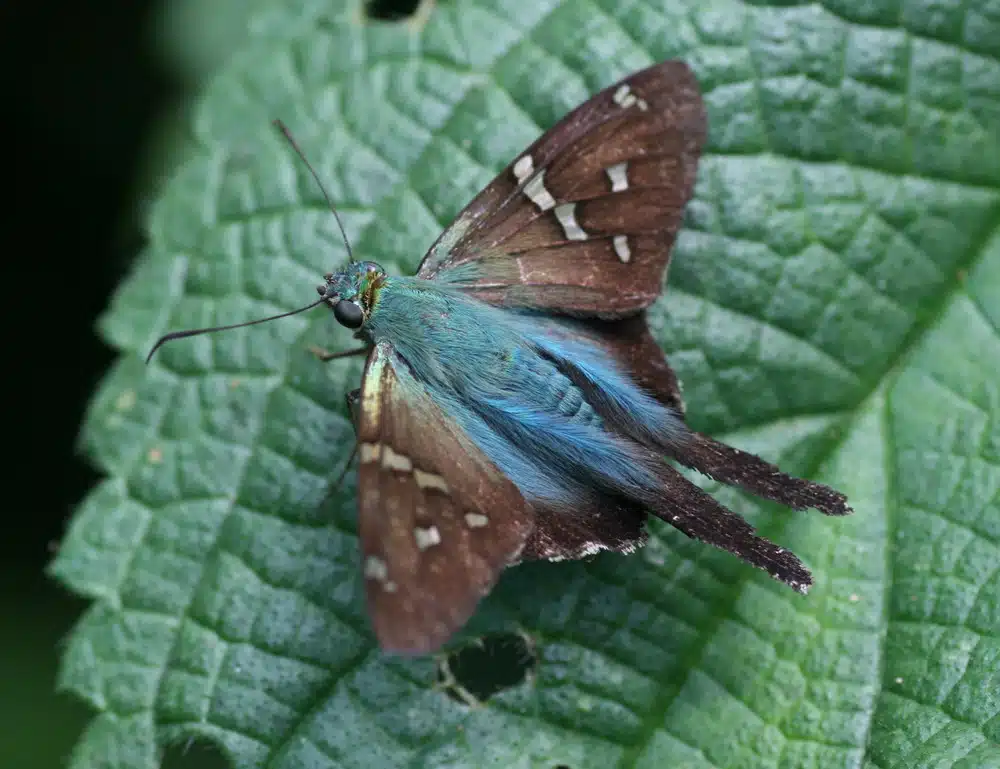
Found along tropical woodlands, Esmeralda Longtails (Urbanus esmeraldus) are only native to Southern parts of Texas in the US.
This species is mostly seen across Central America, especially in Mexico.
This species has dark brown coloring with white and black marks and margins.
Black tails are seen on the lower hindwings of the Esmeralda Longtail.
You can find some of its eggs on host plants such as Beggar’s Ticks. This is only a place for its eggs and larvae to grow as adult Esmeralda Longtails feed on plant nectar.
12. Zebra Swallowtail
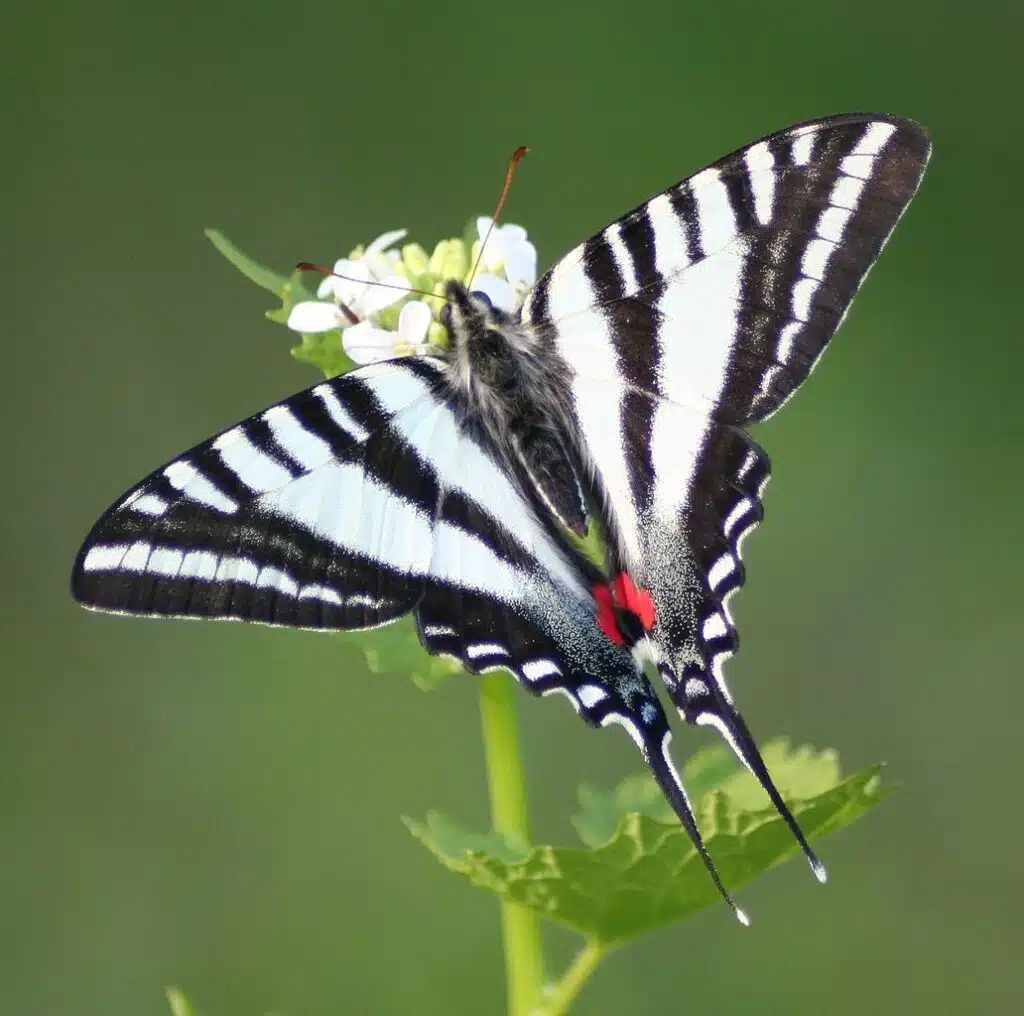
Zebra Swallowtails (Eurytides marcellus) are some of the most common butterflies with tails. Furthermore, these are among the rare butterflies with bicolored tails.
You can identify the species by its black and white stripes and its black tails with white borders.
The species has a mostly black body with narrow white lateral stripes.
Red and blue marks are visible at the base of the hindwings and the base of its tails.
Zebra Swallowtails are among the small to medium-sized species in North America.
This species can be seen in Southeastern US habitats.
Zebra Swallowtails are also known for having cannibalistic caterpillars. Its caterpillars consume other caterpillars regardless of food availability.
13. Long-tailed Metalmark
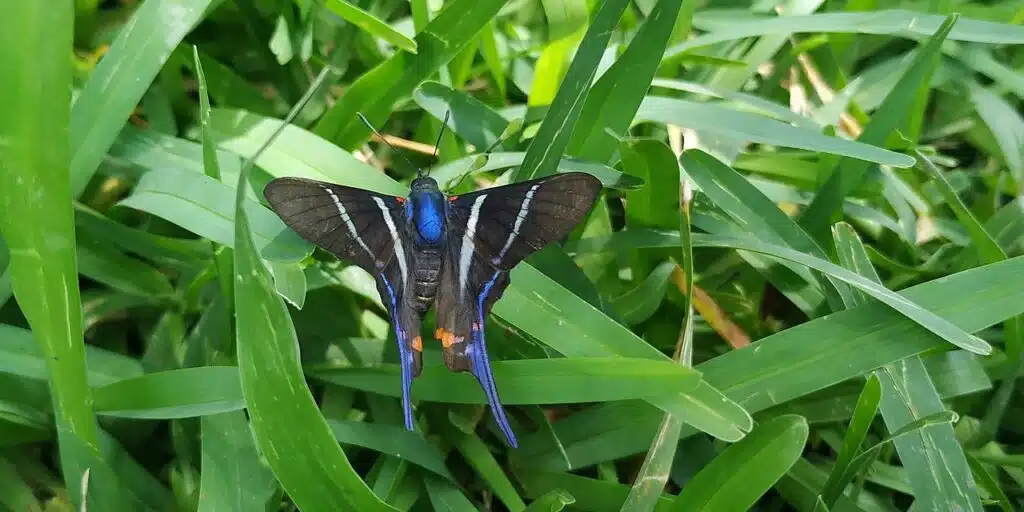
Long-tailed Metalmark Butterflies (Rhetus arcius) are among the rare species that have tails in different colors compared to the rest of the wings.
This species has 2 blue tails with narrow black margins. Its wings are mostly black.
White stripes decorate its wings while blue spots are further visible on the upper side of its wings.
This butterfly species also have pink or purple marks on its lower hindwings.
Long-tailed Metalmarks are sometimes found in the US but are mostly present in Costa Rica and South America.
Long-tailed Metalmarks can be found in riparian areas or areas with sufficient vegetation around sources of water such as ponds, streams, and rivers.
14. White Dragontail Butterfly
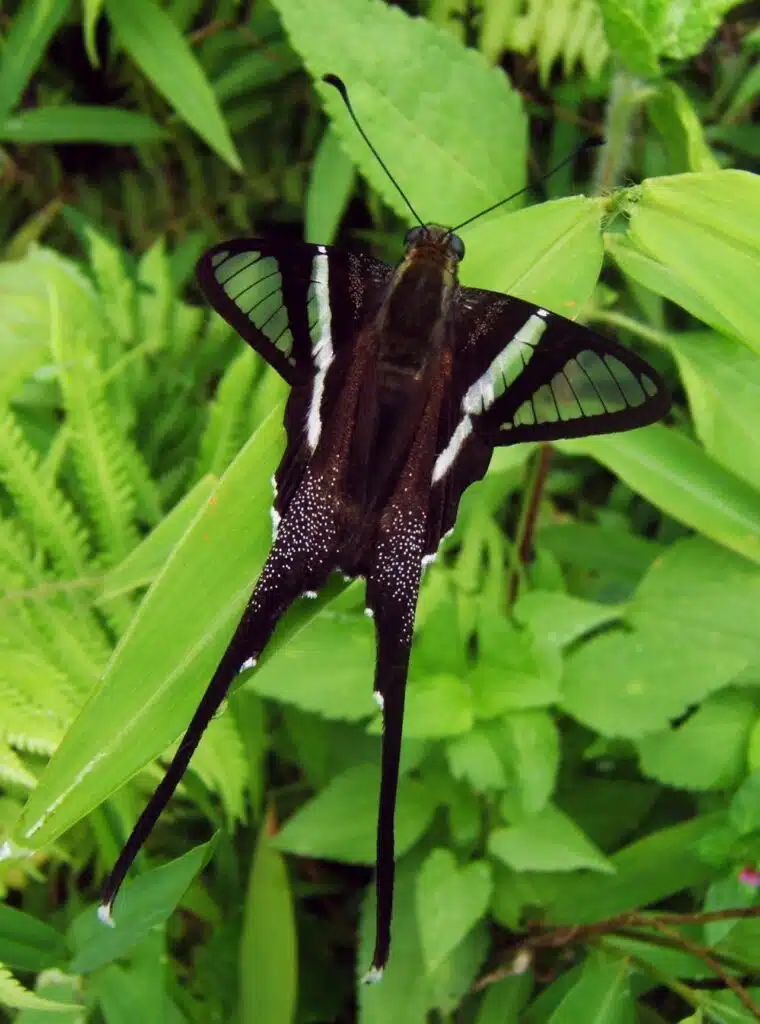
White Dragontail Butterflies (Lamproptera curius) are some of the largest species with very long tails. Their tails can have the same length as their wingspan.
This species is native to regions of Asia.
You can find White Dragontails in Burma, China, Thailand, and Vietnam.
This species stands out with multiple physical characteristics such as having transparent wings with visible black veins.
Its black tails are long and characterized by a white contrasting tip. White areas are also seen across its forewings as well as across the margins of the hindwings.
This species is not as common as it used to be. It’s even a protected species across some Southeast Asia regions so it can’t be collected.
15. Green Dragontail Butterfly
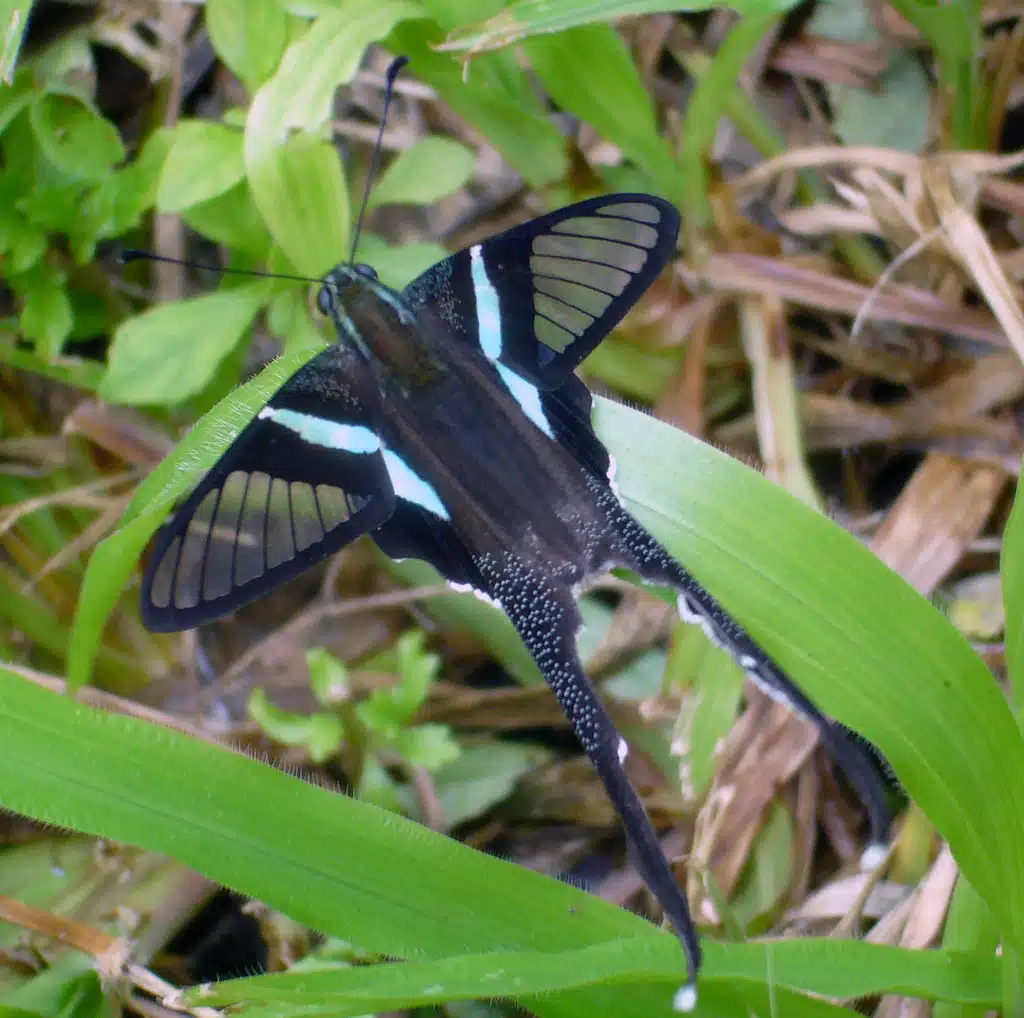
Green Dragontail Butterflies (Lamproptera meges) are named by the green stripes visible on their forewings.
The green sections are closer to the body while the outer forewings are almost transparent.
Its hindwings and its body are black. The tails of the species are long and black.
Tiny white or green dots are visible across its black tails.
Green Dragontail Butterflies maintain some of the green colorings that dominate the look of their green and black caterpillars.
Butterflies of this genus are adapted to living in different habitats at various altitudes.
They can be found in valleys, fields, and at higher elevations of up to 5.000 feet.
16. North American Luna Moth
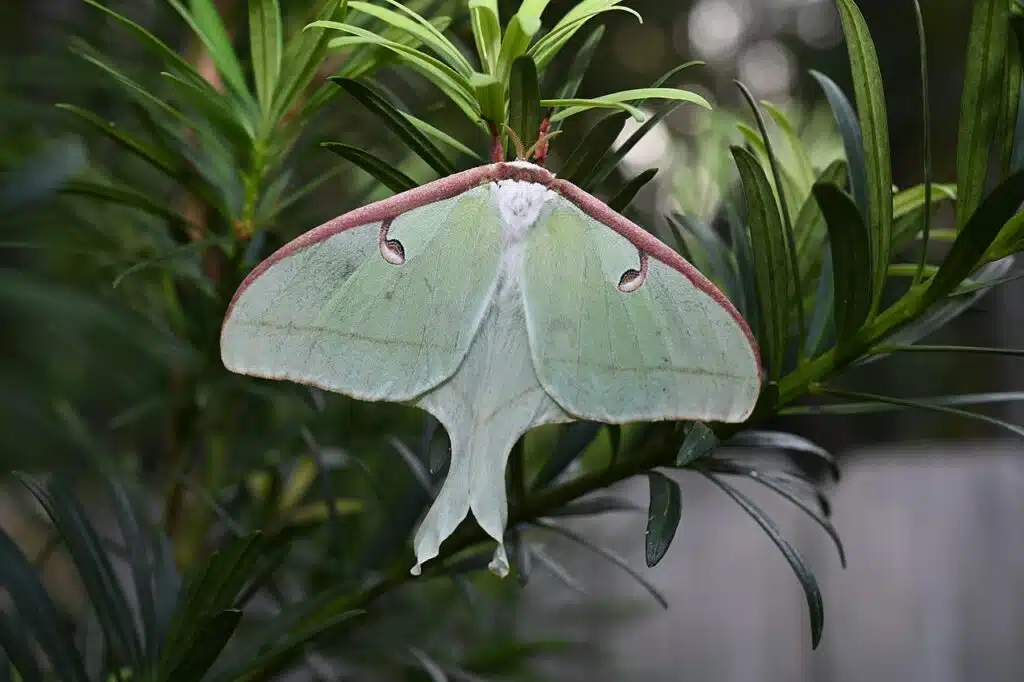
North American Luna Moths (Actias luna) are among the few species with uniform green coloring. Bright green colors are also specific to the tails of this butterfly.
With a wingspan of up to 7 inches, North American Luna Moths are also among the largest moths in the United States.
Caterpillars of the species are also mostly green.
Both caterpillars and adult North American Luna Moths are commonly found on various trees such as birch. The larvae of the species feed on the leaves of the host trees.
White birches are among the most common hosts for North American Luna Moths.
Females lay eggs directly on the wings of the trees about to be consumed.
Up to 400 eggs can be laid by a North American Luna Moth at a time.
17. Chinese Moon Moth
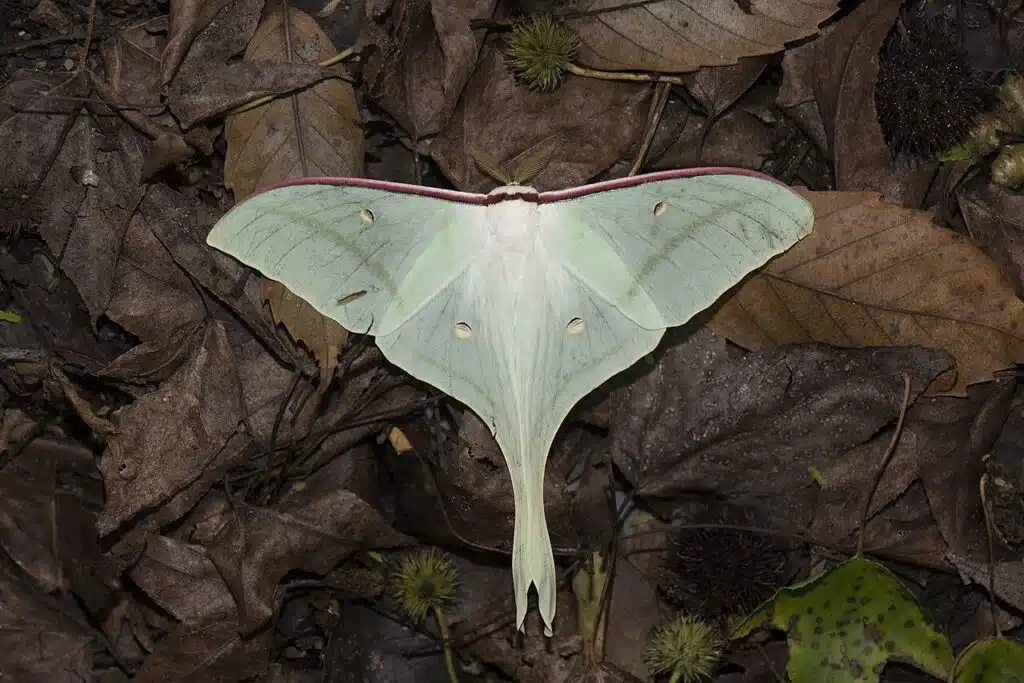
Similarly to North American Luna Moths, Chinese Moon Moths (Actias ningpoana) have bright green uniform color across the wings and the body.
This species also has long green tails.
Chinese Moon Moths are among the most common species of non-feeding moths in China and other regions of Asia.
Adults do not feed and only live short lives as a result.
Chinese Moon Moths are some of the largest moths in Asia. They can grow to a wingspan of up to 5.9 inches.
This species is mostly found around large hardwood trees. It doesn’t have a single host tree as it prefers multiple species found around China.
Camphor and sweetgum are among the trees most likely to host the species.
18. Indian Moon Moth
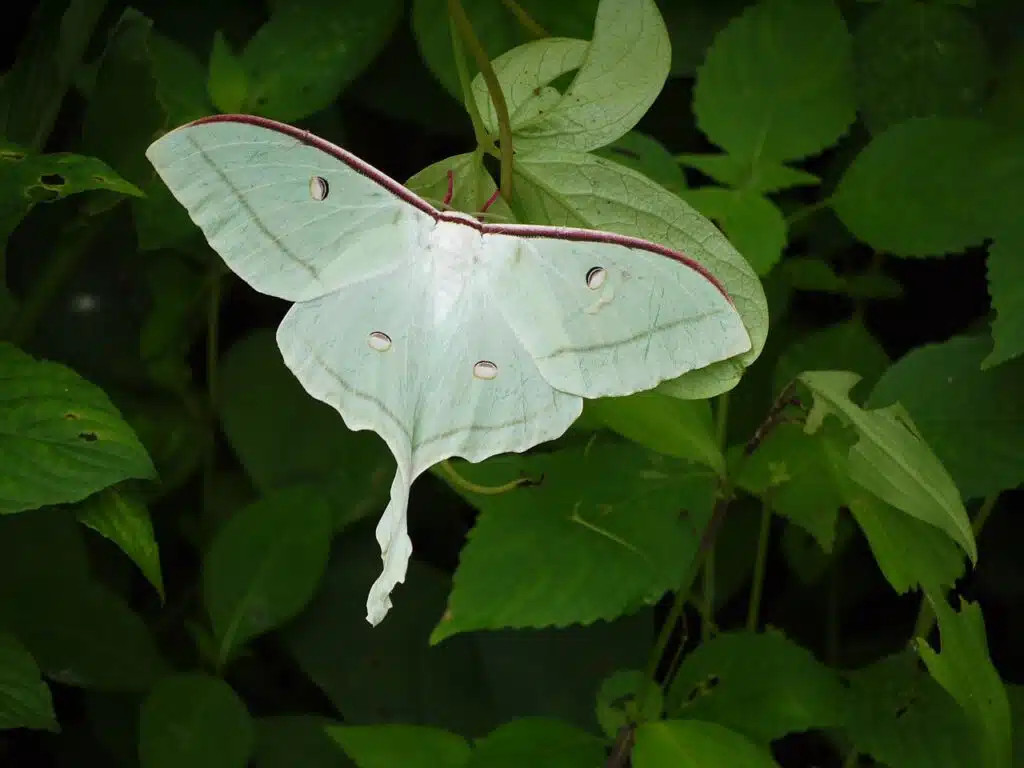
Indian Moon Moths (Actias selene) are common green moths across parts of Asia.
This species stands out with its bright green coloring specific to its wings and its body. It also stands out with its green and red tails.
Indian Moon Moths have red tails at the base, right next to the lower hindwings.
They have green colors at the tips of the tails.
This species further exhibit distinguishing marks such as a red band across the upper forewings.
It also shows red and black eyespots across the forewings.
Late instar Indian Moon Moth caterpillars also show similar characteristics such as a green base color with a redhead and red dots across the body.
19. South China Moon Moth
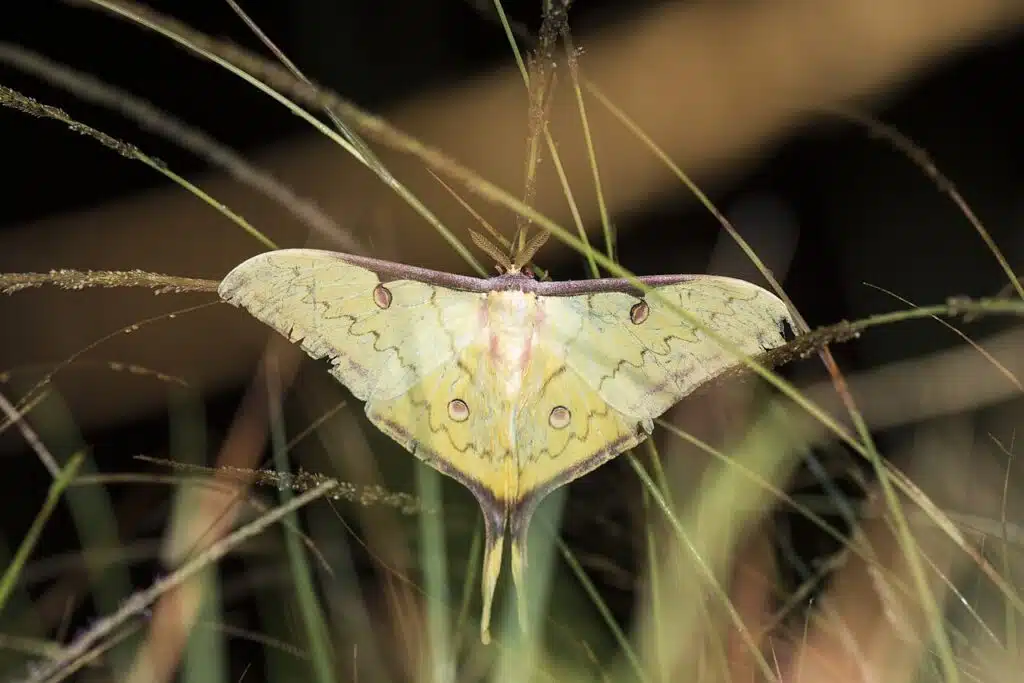
China and Taiwan are among the countries where the South China Moon Moth (Actias sinensis) is highly common.
This species has yellow and green or green coloring across its body.
Males are known to have wider yellow areas across the wings while females are mostly green.
Both males and females stand out with pale colors which are almost white.
Both males and females have long tails.
Male South China Moon Moths have yellow and brown tails. Females have all-green tails.
20. Malaysian Moon Moth
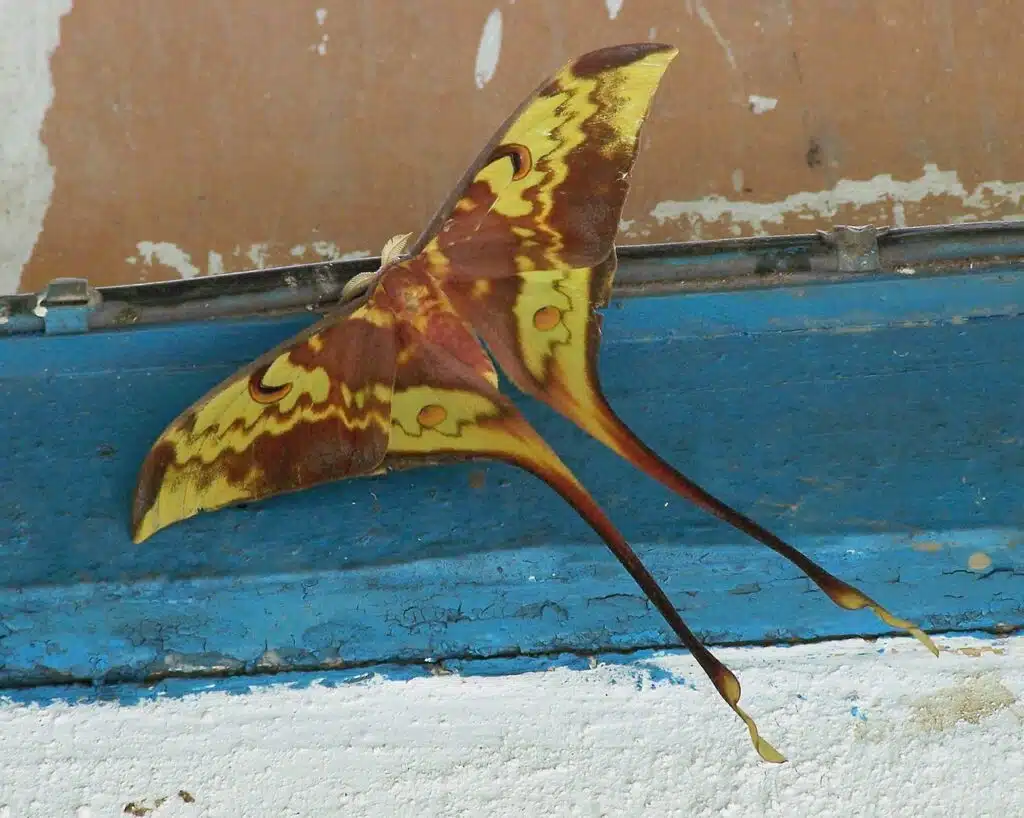
Malaysian Moon Moths (Actias maenas) are native to Asia. They have long tails that surpass the length of their wingspan.
This species has multiple color combinations between sexes.
Males have brown and yellow coloring. They have brown wings close to the body and green outer wings.
Dark brown coloring is specific to the long tails of the male.
Female Malaysian Moon Moths have a bright green color. This green coloring is seen across its wings, body, and tails.
Malaysian Moon Moths can be seen across Asia, specifically in woodlands.
21. Hercules Moth
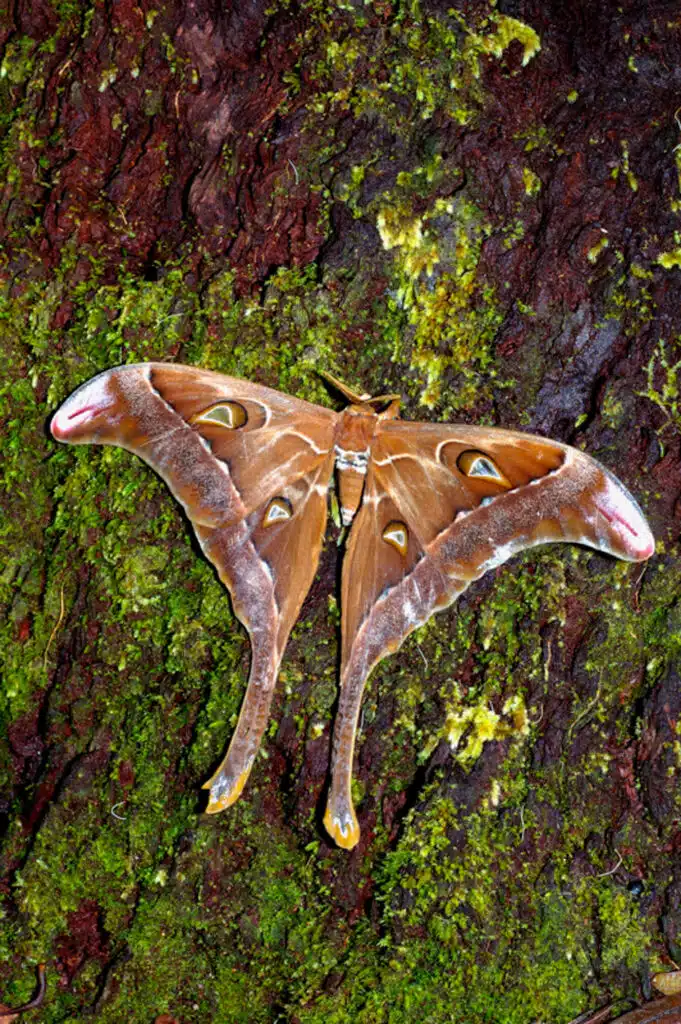
Hercules Moths (Coscinocera hercules) are among the largest insects in the world. This is also the largest species of moths in Australia.
A moth of this species can reach a wingspan of up to 11 inches, making it a large target for predators.
Long tails make it a bit more difficult to catch for some of its typical predators.
Apart from its extreme size, a Hercules Moth can further be identified by its dark brown and black wings with white spots.
Its tails are black and brown with white patterns.
The body of the species is also black and brown.
You can find Hercules Moths on many types of local hos trees such as Cheese trees.